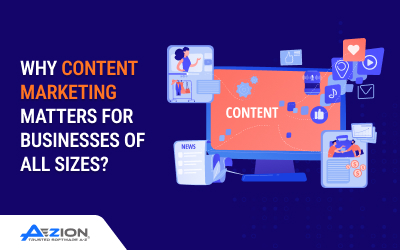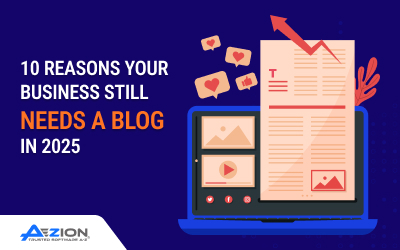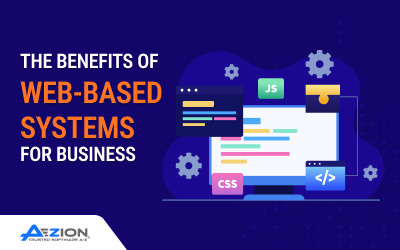Enterprise information management (EIM) specialists dedicate themselves to discovering robust solutions to optimize an organization’s use of information. EIM tools do the same, helping an organization gain visibility and access to useful information on a day-to-day basis in order to support decision making and knowledge sharing.
A handful of out-of-the-box EIM solutions do exist, but most organizations find that these solutions offer very little, at least not without extreme customization by in-house developers. Instead of licensing existing solutions, most organizations turn to a custom software development firm to create tailor-made EIM software for their needs.
If you’re looking for enterprise information management tools to help drive business outcomes, Aezion can help. Contact us today to learn about our custom development approach.
Why Do You Need EIM Software?
Organizations are being met with an ever-increasing amount of unstructured data along with increasingly strict regulations surrounding how they collect, store, and use information. Together, these things put organizations under pressure to improve security and efficiency when it comes to managing their information, and they’re also trying to do it all while reducing costs.
With an enterprise information management solution, an organization is able to unlock simplified and cost-effective infrastructure to securely contain its information in an organized and accessible manner. An effective EIM solution can require minimal support from IT, and cloud-based solutions can permit anyone in the organization to access the data they need from anywhere without delay.
The right EIM solution will complement other systems within the business while saving time, eliminating data siloes, and reducing the cost of keeping and maintaining data. With all of that in mind, the single biggest advantage that EIM software brings to the table is improved decision making because improved accessibility means better insights all of the time.
Tips for Choosing Custom EIM Software
The challenge with enterprise information management software isn’t deciding whether or not it would be beneficial to your organization. Rather, the biggest hurdle is determining which solution is the right fit for your unique needs.
Many companies choose to go with custom software because out-of-the-box solutions can require a great deal of customization to fit their environment and workflows. Regardless of whether you choose something custom or license an existing solution, follow these tips to ensure its success.
1. Consider Necessary Integrations
The primary goal of enterprise information management software is to organize your information in one place and make it more accessible to everyone who needs it. This requires integrations at both ends. Some integrations will allow data to flow into your EIM software while others will allow data to be organized, manipulated, and shared with people throughout your organization.
Before you select a particular EIM software, you must ensure that it has the proper integration capabilities to meet your needs. Consider the software that your business is currently utilizing and whether or not you intend to replace or retire any of it. Then, think about the software your company is considering implementing in the next year. If anything needs to connect to your EIM, you don’t want to be surprised to learn that you must wait for an integration to go live.
2. Automate and Streamline Data Flows
An enterprise information management system is only as valuable as the data it contains, which means having a system that cannot automatically capture or update data will cost you. The EIM software you select should be able to automatically extract data from documents and other information sources and then organize it and make it instantly accessible to the enterprise.
Moreover, your EIM software should take automation a step further by streamlining document approvals and giving your teams tools to improve visibility and effectiveness of business processes. Ideally, workflows should run hands-free and dashboards should provide real-time status updates to minimize that the need for employees to manually follow up on tasks.
Fortunately, automation is rapidly becoming the standard in enterprise software, so it’s actually rare to find EIM software that doesn’t attempt to streamline data flows, but you should still look closely at advertised features, ask questions, and avoid assumptions that could result in choosing the wrong solution.
3. Consider Records Security and Management
Carefully consideration of your organization’s data privacy and security requirements is a prerequisite to considering an enterprise information management solution. As regulations continue to grow stricter regarding what information companies can collect, store, and use, it’s essential that you choose an EIM solution that supports regulatory compliance instead of complicating it.
For example, your enterprise information management software should include records management features that help you minimize risks. These include setting timelines for when files are destroyed, specifying encryption methods to keep data safe, implementing version control to protect data integrity, and using digital signatures to maintain security throughout the entire lifecycle of your data.
4. Demand Advanced Reporting and Analytics
The main driver of value for an enterprise information management tool is the insights it will allow you to gain, but this means nothing if you have to go digging for them. That’s why advanced reporting and analytics are the hallmarks of any good enterprise information management software. You should have complete visibility into the information your EIM system contains and it should produce real-time insights on its own, without the need for human input.
A robust, intuitive, and interactive dashboard should act as a “home base” where you can filter how data is displayed and manipulate visuals to quickly understand and share meaningful insights, especially across disciplines and departments. If an EIM tool makes data difficult to use or understand, that’s a sure sign that it’s not a good fit.
Custom Enterprise Information Management Software That Drives Results
At Aezion, we create custom software that connects people and systems, drive results and enable enterprise-wide visibility, collaboration and coordination. Are you interested in learning more about how we can help your company grow with a custom enterprise information management integration? Contact us today and speak with an expert.



